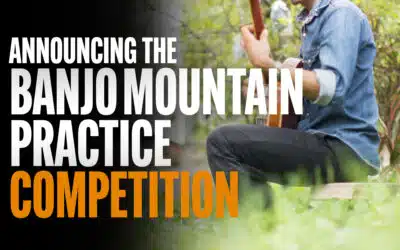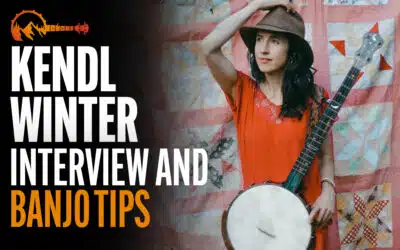So, you’ve got your hands on your first 5-string banjo and now (naturally) you want to learn how to play the darn thing. And that’s when you make the discovery: there’s actually two styles of playing – clawhammer and bluegrass – common to the 5-string. So how the heck do you decide which one to learn?? Before we do check out our video of examples of both:
Clawhammer Banjo
Clawhammer banjo, or frailing, traces its roots back to West Africa and was introduced to the American Colonies by African slaves. By the time of the American Revolution, this style of playing had become firmly established as a staple of American plantation music. In the early nineteenth century, it became an integral part of American minstrel shows, a form of entertainment that parodied southern plantation life. These shows, performed widely in both the New World and Europe, were responsible for introducing clawhammer banjo to the world.
Clawhammer banjo is played using a downward strumming motion over the strings. Typically, the melody of a song is played by striking one string, quickly followed by a strum of two or three strings. This creates a rhythm that sounds like: “boom – chick – a” or, more precisely, “claw – ham – mer.”
Bluegrass Banjo
You might be surprised to learn that BLUEGRASS banjo is at least three centuries younger than clawhammer banjo; it was developed in the American south in the early twentieth century. Unlike clawhammer, bluegrass banjo avoids strumming altogether. Instead, fingerpicks are used on the thumb, index and middle fingers; the strings are plucked in the same manner a classical guitarist plucks the strings of a guitar.
Earl Scruggs is generally considered to be the originator of this style of banjo playing. Despite the assumption that he singlehandedly “invented” bluegrass banjo, Scruggs had contemporaries who used a similar three-finger style approach. Scruggs simply borrowed ideas from these pickers and synthesized them into a more refined, flashier style. Scruggs also had the advantage of being the first banjo player to showcase this style of playing to a wide audience through his work with Bill Monroe and the Bluegrass Boys at the Grand Ole Opry.
Rolls
The defining feature of bluegrass banjo playing (commonly referred to as “Scruggs style”) is that the melody of a song is embedded in a series of picking patterns called “rolls.” These rolls are what make bluegrass banjo playing sound so impressive. Unlike clawhammer banjo, whose melodies tend to be fairly discernible, in bluegrass banjo the melody of a song can often become lost in a tidal wave of other notes (which is why this style of playing is so ear-catching).
Now that you have a basic idea of these two different styles of banjo playing, let’s address that all-important question – which one should you learn?
Which Style Of Banjo Should I Learn?
From my own experience, many would-be banjo players won’t even consider this question without first knowing which style is easier. When I’m confronted with this question by a student, my answer is always the same: that depends.
Specifically, it depends on how much time you devote to practicing and the quality of your practice sessions. If you’re committed to learning the instrument, this question becomes irrelevant. After all, every instrument (and style of playing) has its own quirks and idiosyncrasies, making comparisons from one to another somewhat tricky. To employ an old bromide, it’s apples and oranges. The deciding factor in this equation is how much deliberate, dedicated practice you’re willing to put into learning your instrument. (For more on deliberate practice, see our blog post “The Best Way To Learn Banjo”.)
My suggestion would be to listen to examples of the two styles. Go to YouTube or, even better, attend a live music event. Find out which style calls to you and moves you on an emotional level. Maybe both? Incidentally, there’s nothing wrong with tackling both styles. I’ve taught quite a few students who’ve done just that (and quite successfully, I might add!)
Hopefully, this information will make the task of deciding which banjo style to learn a little less daunting. And the sooner you make that decision, the sooner you’ll be making some bee-too-tee-ful banjo music! Exciting, huh?
You might also enjoy our breakdown of open back banjos vs banjos with resonators post useful.
FULL ACCESS TO 200+ LESSONS
START LEARNING BANJO NOW!

Annual Subscription
SAVE OVER 70%Full access to Banjo Mountain (200+ lessons) for $139.95 saving you over 70%.
Bills annually. Cancel anytime.
3-Month Subscription
Full access to Banjo Mountain (200+ lessons) for $75 saving you over 35%.
Bills every 3 months. Cancel anytime.
1-Month Subscription
Full access to Banjo Mountain (200+ lessons) for $40.
Bills monthly. Cancel anytime.
STILL NOT SURE?
Latest From Our Blog
Nora Brown: A Rising Star In The Banjo World
Nora Brown is someone to keep your eye on. Indeed, at a young age, she is already turning heads. Hailing out of Brooklyn, New York, Nora has played festivals all over the country. Don’t let Brooklyn throw you off (no offense Brooklyn-ites). While having urban origins,...
The 1st Banjo Mountain Practice Competition
We are pleased to announce the first Banjo Mountain Practice Competition. This is for Banjo Mountain students. It costs nothing to enter and you can do so once you have subscribed. The goal here is to encourage daily practice by submitting your video for your peers to...
Kendl Winter Interview & Banjo Tips
Video interview with Kendl Winter where she shares tips and advice for banjo players, talks about how she got into banjo, what projects she's currently working on and her upcoming album "Banjo Mantras." Her single "Humming Mantra" will be live September 8th! A...



